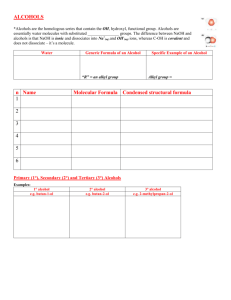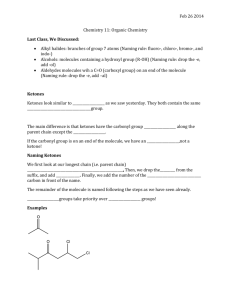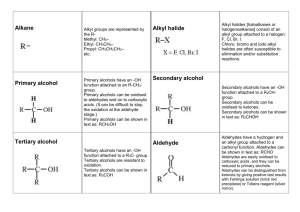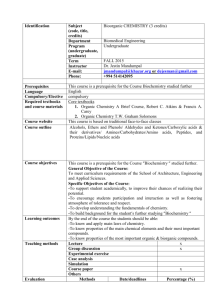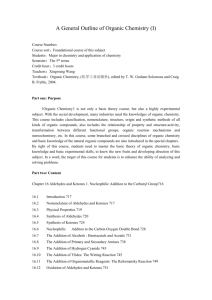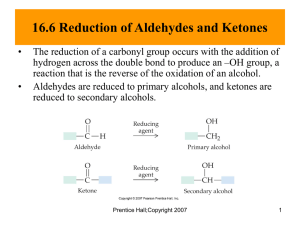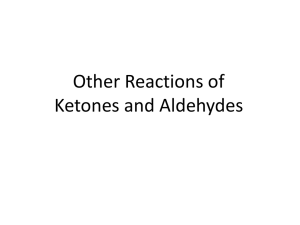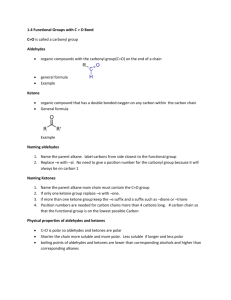Organic Chemistry Questions
advertisement
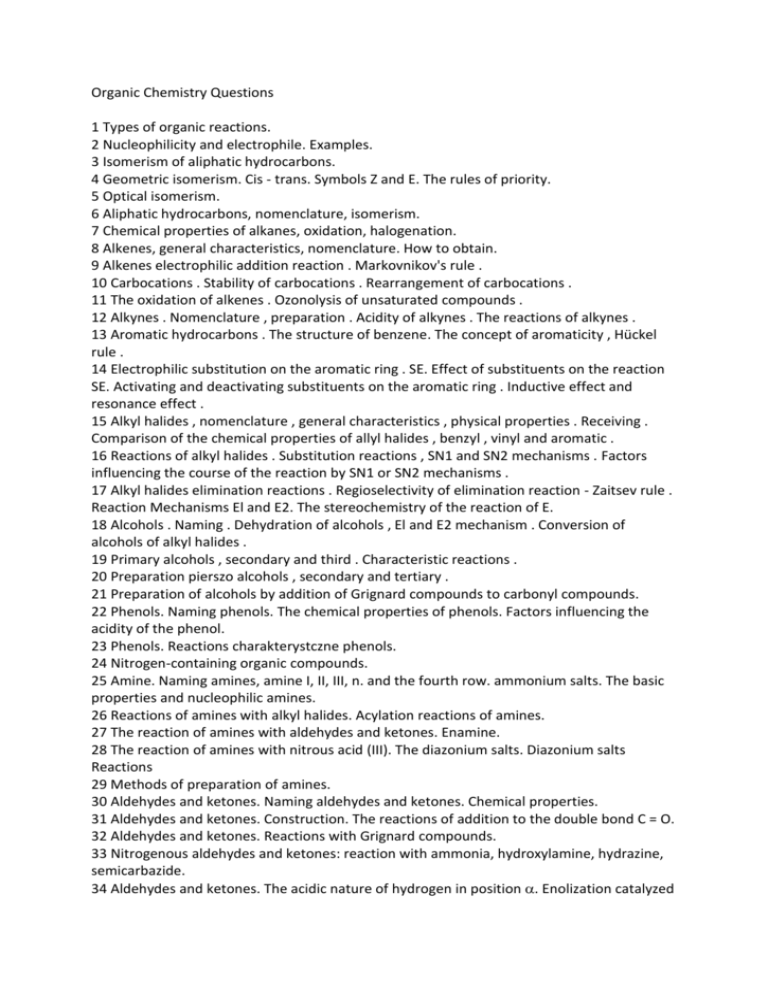
Organic Chemistry Questions 1 Types of organic reactions. 2 Nucleophilicity and electrophile. Examples. 3 Isomerism of aliphatic hydrocarbons. 4 Geometric isomerism. Cis - trans. Symbols Z and E. The rules of priority. 5 Optical isomerism. 6 Aliphatic hydrocarbons, nomenclature, isomerism. 7 Chemical properties of alkanes, oxidation, halogenation. 8 Alkenes, general characteristics, nomenclature. How to obtain. 9 Alkenes electrophilic addition reaction . Markovnikov's rule . 10 Carbocations . Stability of carbocations . Rearrangement of carbocations . 11 The oxidation of alkenes . Ozonolysis of unsaturated compounds . 12 Alkynes . Nomenclature , preparation . Acidity of alkynes . The reactions of alkynes . 13 Aromatic hydrocarbons . The structure of benzene. The concept of aromaticity , Hückel rule . 14 Electrophilic substitution on the aromatic ring . SE. Effect of substituents on the reaction SE. Activating and deactivating substituents on the aromatic ring . Inductive effect and resonance effect . 15 Alkyl halides , nomenclature , general characteristics , physical properties . Receiving . Comparison of the chemical properties of allyl halides , benzyl , vinyl and aromatic . 16 Reactions of alkyl halides . Substitution reactions , SN1 and SN2 mechanisms . Factors influencing the course of the reaction by SN1 or SN2 mechanisms . 17 Alkyl halides elimination reactions . Regioselectivity of elimination reaction - Zaitsev rule . Reaction Mechanisms El and E2. The stereochemistry of the reaction of E. 18 Alcohols . Naming . Dehydration of alcohols , El and E2 mechanism . Conversion of alcohols of alkyl halides . 19 Primary alcohols , secondary and third . Characteristic reactions . 20 Preparation pierszo alcohols , secondary and tertiary . 21 Preparation of alcohols by addition of Grignard compounds to carbonyl compounds. 22 Phenols. Naming phenols. The chemical properties of phenols. Factors influencing the acidity of the phenol. 23 Phenols. Reactions charakterystczne phenols. 24 Nitrogen-containing organic compounds. 25 Amine. Naming amines, amine I, II, III, n. and the fourth row. ammonium salts. The basic properties and nucleophilic amines. 26 Reactions of amines with alkyl halides. Acylation reactions of amines. 27 The reaction of amines with aldehydes and ketones. Enamine. 28 The reaction of amines with nitrous acid (III). The diazonium salts. Diazonium salts Reactions 29 Methods of preparation of amines. 30 Aldehydes and ketones. Naming aldehydes and ketones. Chemical properties. 31 Aldehydes and ketones. Construction. The reactions of addition to the double bond C = O. 32 Aldehydes and ketones. Reactions with Grignard compounds. 33 Nitrogenous aldehydes and ketones: reaction with ammonia, hydroxylamine, hydrazine, semicarbazide. 34 Aldehydes and ketones. The acidic nature of hydrogen in position . Enolization catalyzed by acids and bases. -Halogenation. Halogenation metyloketonów. 35 Aldol condensation of acidic and basic .. 36 Cannizzaro reaction (auto-oxidation and reduction of aldehydes). 37 Preparation of aldehydes and ketones. 38 Carboxylic acids. Naming and chemical properties of the carboxylic acids. 39 Preparation of carboxylic acids. 40 Derivatives of carboxylic acids. Naming. The reactivity of the carboxylic acid derivatives. 41 Chlorides and anhydrides. Naming. Reactivity. Hydrolysis. 42 Esters. Naming. Preparation of esters. The hydrolysis in acidic and basic conditions, alcoholysis, ammonolysis reactions with Grignard compounds. 43 Amides. Naming amides and construction of the amide group. Hydrolysis of amides. Reduction of amides. 44 Hydroxycarboxylic acids. Naming hydroxy acids. Reactions of hydroxy acids. 45 Amino Acids. Naming amino acid and alkaline properties. Preparation of amino acids. The reactions of amino acids (amino groups and carboxyl groups). 46 Peptides. Naming peptides. Peptide bond. Synthesis of peptides. 47 Saccharides. Construction. Division. 48 Sugars isomerism. 49 Disaccharides. 50 Fatty acids. Fats. Soap. 51 Petroleum Chemistry - composition, processing, types of products derived from petroleum refineries and petrochemical plants. 52 Discuss industrial ammonia synthesis process and the method of obtaining nitrogen fertilizers. 53 Polymers - definition, polymerization methods and methods for the study of physicochemical properties of the polymers. 54 Free radicals - structure, stability, reactivity, reaction mechanisms that involve free radicals and methods for their examination. 55 Give and discuss three arbitrarily selected examples of methods for studying the mechanisms of organic reactions. 56 The types and characteristics of the catalysts used in the chemical industry. 57 Types of instrumental methods used in testing the purity chemicals.
